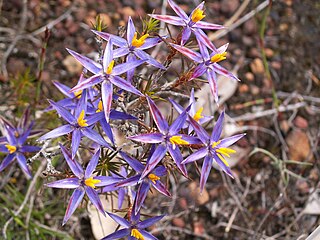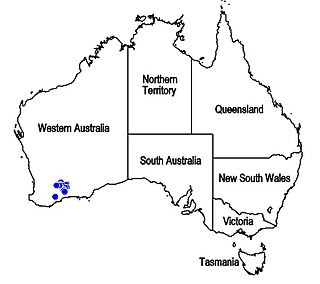
Lechenaultia is a genus of flowering plants in the family Goodeniaceae, the species native to Australia with one species also occurring in New Guinea. Plants in the genus Lechenaultia are glabrous shrubs or herbs with needle-shaped leaves, more or less sessile flowers with five sepals and five blue, white, or yellow and red petals in two unequal lobes, the fruit an elongated capsule.

Calectasia is a genus of about fifteen species of flowering plants in the family Dasypogonaceae and is endemic to south-western Australia. Plants is this genus are small, erect shrubs with branched stems covered by leaf sheaths. The flowers are star-shaped, lilac-blue to purple and arranged singly on the ends of short branchlets.

Calectasia intermedia, commonly known as blue tinsel-lily or eastern tinsel lily is a species of flowering plant in the family Dasypogonaceae, endemic to the border areas of western Victoria and south-eastern South Australia and flowering in early spring. It is the only member of the genus Calectasia that is not endemic to Western Australia.

Calectasia grandiflora, commonly known as the blue tinsel lily, is a plant in the family Dasypogonaceae growing as a perennial herb endemic to the south-west of Western Australia. It flowers in spring.

Calectasia cyanea, commonly known as the star of Bethlehem or blue tinsel lily, is a plant in the family Dasypogonaceae growing as a perennial herb and is endemic to the south–west of Western Australia. Restricted to a single population in Torndirrup National Park, it is critically endangered.
Calectasia browneana, commonly known as blue tinsel lily, is a plant in the family Dasypogonaceae growing as a spreading, perennial, tufted herb. It is an uncommon species, endemic and restricted to a few areas in the south-west of Western Australia. It is similar to the other species of Calectasia and has only been recognised as a separate species since a review of the genus in 2001. It is distinguished from the others mainly by the hairiness of its leaves and lack of a rhizome.

Calectasia gracilis, commonly known as blue tinsel lily, is a plant in the family Dasypogonaceae and is endemic to the south-west of Western Australia. It is a spreading, tufted, woody, perennial herb with blue petals and six yellow stamens that turn orange-red as they age. It is similar to the other species of Calectasia and has only been recognised as a separate species since a review of the genus in 2001.
Calectasia keigheryi, commonly known as blue tinsel lily, is a plant in the family Dasypogonaceae growing as an erect, rhizomatous, perennial herb. It is an uncommon species, endemic and restricted to a few areas in the south-west of Western Australia. It is similar to the other species of Calectasia and has only been recognised as a separate species since a review of the genus in 2001. It is relatively easily distinguished from the others mainly by its smaller flowers, unusual anther shape, and hairs on the lower part of the petals.

Calectasia narragara, commonly known as a blue tinsel lily or star of Bethlehem, is a plant in the family Dasypogonaceae growing as a tufted rhizomatous herb. It is endemic to the southwest of Western Australia and common in most of its range.
Calectasia pignattiana, commonly known as the stilted tinsel lily or Pignatti's star of Bethlehem, is a plant in the family Dasypogonaceae growing as a perennial herb and is endemic to the south–west of Western Australia. It is only known from ten locations, four of which are on road verges. The species is classified as vulnerable.

Calectasia obtusa, commonly known as a blue tinsel lily or blunt-leaved tinsel lily is a plant in the family Dasypogonaceae growing as an erect, small shrub with stems to 50 cm. It is endemic to the south-west of Western Australia, widespread in most of its range but only known from nine populations.
Calectasia palustris, commonly known as a blue tinsel lily or swamp tinsel lily is a plant in the family Dasypogonaceae growing as a perennial, tufted herb with stilt roots. It is an uncommon species, endemic and restricted to a few areas in the south-west of Western Australia. It is similar to the other species of Calectasia and has only been recognised as a separate species since a review of the genus in 2001.
Eremophila grandiflora is a flowering plant in the figwort family, Scrophulariaceae and is endemic to Western Australia. It is a large shrub with shiny leaves and the largest flowers in its genus and is only known from a restricted area near Paynes Find.
Eremophila hispida is a flowering plant in the figwort family, Scrophulariaceae and is endemic to Queensland. It is a small shrub with narrow, hairy, clustered leaves, with violet to purple flowers and is restricted to a small area in central Queensland.

Eremophila veronica, commonly known as veronica-like eremophila, is a flowering plant in the figwort family, Scrophulariaceae and is endemic to Western Australia. It is a low, spreading shrub with small, crowded leaves and lilac-coloured flowers which have a short petal tube and spreading petal lobes.
Dasymalla axillaris, commonly known as native foxglove or woolly foxglove, is a flowering plant in the mint family Lamiaceae and is endemic to Western Australia. It is a small, diffuse shrub with its branches, leaves and some of its flower parts densely covered with white, woolly hairs. The flowers are a shade of red and tube-shaped with the stamens and style extending beyond the end of the five petals.

Dasymalla terminalis, commonly known as native foxglove, is a flowering plant in the mint family Lamiaceae and is endemic to the south-west of Western Australia. It is a shrub with its branches, leaves and some of its flower parts densely covered with white, woolly hairs. The leaves are thick and soft and the flowers are tube-shaped, pale to deep pinkish-purple or claret red.

Hemiphora lanata is a flowering plant in the mint family Lamiaceae and is endemic to the south-west of Western Australia. It is a sprawling shrub with its branches and leaves densely covered with white, woolly hairs and with deep pink or dark red, curved, tube-shaped flowers with spreading petal lobes on the end. It is similar to Hemiphora exserta except for its cottony leaf-covering and its longer stamens.

Caladenia dundasiae, commonly known as the Patricia's spider orchid and Dundas spider orchid, is a species of orchid endemic to a small area in the south-west of Western Australia. It is a rare orchid with a single hairy leaf and one or two, usually red flowers with thin, stiffly-held lateral sepals and petals.
Hibbertia lividula is a species of flowering plant in the family Dilleniaceae and is endemic to the south-west of Western Australia. It is an erect or sprawling shrub with thin branchlets, bluish-grey, narrow elliptic to narrow oblong leaves and yellow flowers, with thirty to forty stamens arranged around the five glabrous carpels.











